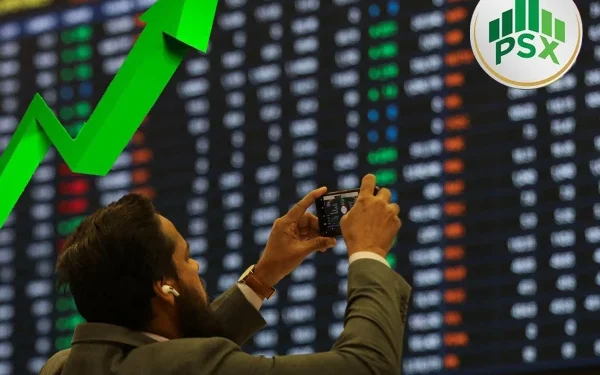Introduction: A Historic Surge in the Pakistan Stock Exchange
Karachi: The Pakistan Stock Exchange (PSX) has entered a new and unprecedented phase of growth and investor confidence. As of mid-July 2025, the KSE-100 Index has surged past the historic milestone of 134,000 points, marking one of the most remarkable recoveries in Pakistan’s financial history. This surge comes as a symbol of renewed economic hope in a country that was, not long ago, grappling with predictions of default, soaring inflation, and a currency crisis.
This dramatic transformation highlights not only the resilience of Pakistan’s financial institutions but also the improving macroeconomic indicators and sound policy measures implemented in recent times. What once seemed like a distant dream—economic revival, investor confidence, and regional integration—is now taking visible shape in the country’s financial markets.
From Crisis to Confidence: The Turning Point
Over the past several years, Pakistan faced numerous economic challenges. Between 2020 and 2023, the country saw a steep decline in its currency, rising inflation that crossed 30%, record-high interest rates, and depleting foreign exchange reserves. These conditions led to fears of a looming default.
However, by 2024 and now into 2025, Pakistan’s economic strategy has seen a radical shift. The monetary tightening cycle, once necessary to curb inflation, has now given way to a period of easing. With the interest rate dropping from 22% to 11%, borrowing costs for businesses have become more manageable, reigniting economic activity and investor interest.
This policy shift, combined with improved global perception and regional diplomacy, has laid the groundwork for the recent stock market rally.
The China-Pakistan Economic Corridor (CPEC) and Regional Integration
At the heart of Pakistan’s economic revival lies its deepening ties with China, particularly through the China-Pakistan Economic Corridor (CPEC). Initially launched in 2015 as part of China’s broader Belt and Road Initiative (BRI), CPEC has now matured into a multifaceted platform for infrastructure development, energy cooperation, and trade expansion.
What once seemed like an ambitious plan is now bearing fruit:
- Power plants built under CPEC have reduced Pakistan’s chronic electricity shortfall.
- Motorways and highways have improved connectivity across provinces.
- Special Economic Zones (SEZs) are attracting industrial investment.
Furthermore, improved relations with countries such as Iran, Afghanistan, Saudi Arabia, Turkey, Azerbaijan, and Uzbekistan have solidified Pakistan’s strategic position in the region. Enhanced defense and economic collaboration with China also adds to the country’s security and trade prospects.
Macroeconomic Indicators: Signs of Stabilization
Several key macroeconomic indicators point toward Pakistan’s improving financial health, including:
- Stable Pakistani Rupee: After years of depreciation, the rupee has stabilized due to improved foreign exchange reserves and reduced current account deficit.
- Record-high Foreign Exchange Reserves: Pakistan’s reserves now stand at their highest levels in over five years, offering a buffer against future external shocks.
- Controlled Inflation: Inflation, which had touched worrying levels, has now been brought down through effective fiscal and monetary coordination.
- Interest Rate Reduction: With the policy rate cut to 11%, the cost of doing business has significantly declined, encouraging both local and foreign investment.
Panda Bonds and Return to Global Markets
One of the most notable developments is Pakistan’s preparation to return to international debt markets through the issuance of Panda Bonds—Yuan-denominated bonds issued in the Chinese market. The increased appetite for Pakistani bonds, reflected in rising prices and falling yields, signals growing global investor confidence.
The Panda Bond strategy is also a part of Pakistan’s de-dollarization approach, as the country looks to strengthen bilateral currency swaps and trade arrangements, particularly with China and Russia.
Sectoral Growth and Investment Opportunities
With a more stable macroeconomic environment, various sectors of the Pakistani economy are becoming increasingly attractive for investment, both domestic and foreign. Among the most promising areas are:
1. Minerals and Mining
Pakistan is rich in natural resources, including copper, gold, lithium, and rare earth minerals. The recent Reko Diq agreement and new exploration licenses have revitalized investor interest in the mining sector.
2. Information Technology (IT) and Tech Startups
With a young population and growing internet penetration, Pakistan’s IT exports have surged, crossing the $3 billion mark in 2025. Government incentives for freelancers, startups, and tech incubators are helping develop a digital ecosystem that can attract global capital.
3. Tourism
The improved security situation and better infrastructure have led to a revival in domestic and foreign tourism, especially in northern Pakistan, cultural heritage sites, and religious tourism hubs.
4. Agriculture and Agri-Tech
Agriculture remains the backbone of the economy. With a renewed focus on smart farming, digital irrigation, and organic exports, Pakistan’s agri-sector is poised for modernization.
Pakistan Stock Exchange (PSX) as a Barometer of Growth
The KSE-100 Index crossing 134,000 points is more than just a number—it reflects market sentiment, investor expectations, and the underlying strength of listed companies. Sectors leading the surge include:
- Banking and Financial Services
- Cement and Construction
- Energy and Power
- Textiles and Export-oriented Industries
- Technology and Telecom
Analysts are optimistic that if stability persists, the Price-to-Earnings (P/E) ratio of the KSE-100 could return to double-digit levels, suggesting strong corporate profitability and investor returns.
Investor Advisory: Strategic Stock Market Participation
While the PSX is on the rise, experts advise cautious optimism. Market cycles are influenced by both domestic and global factors. Therefore, potential investors are encouraged to:
- Conduct thorough research on stocks
- Review financial statements and quarterly earnings reports
- Examine the corporate governance and management practices
- Avoid speculation and focus on long-term value investing
Reasonable profits are expected over the next 2–3 years, particularly in companies with sound fundamentals and exposure to growth sectors.
The Role of Government Reforms and Economic Strategy
The current government’s focus on fiscal discipline, tax reform, and investor facilitation has played a crucial role in stabilizing the economy. Some key reforms include:
- Introduction of digital payment systems and tax automation
- Expansion of public-private partnerships
- Launch of the Special Investment Facilitation Council (SIFC) to streamline FDI processes
- Reforms in SOEs (State-Owned Enterprises) to improve efficiency and transparency
These reforms not only improve investor confidence but also help Pakistan fulfill conditions laid out by global financial institutions like the IMF, World Bank, and ADB.
Future Outlook: Challenges and Opportunities
While the signs are positive, Pakistan must remain vigilant. Key challenges that still require long-term solutions include:
- Political instability and uncertainty ahead of the next general elections
- Structural reforms in energy pricing, subsidies, and tax collection
- Debt servicing burden and reliance on external borrowing
- Climate vulnerability, particularly affecting agriculture and water resources
However, if the current momentum is maintained, Pakistan can transform these challenges into opportunities, strengthening its position as a rising economic force in South Asia.
Conclusion: Toward a Resilient and Prosperous Pakistan
The recent rally in the Pakistan Stock Exchange is not an isolated event—it reflects a broader economic revival, investor optimism, and strategic policymaking. From the recovery of macroeconomic indicators to the expansion of trade ties and industrial growth, Pakistan is stepping into a new era of stability and prosperity.
As global markets take notice, and regional allies deepen their ties with Pakistan, the country is well-positioned to attract foreign direct investment, expand exports, and empower its growing middle class.
The journey is far from over, but the foundations for long-term economic success are finally being laid.

























